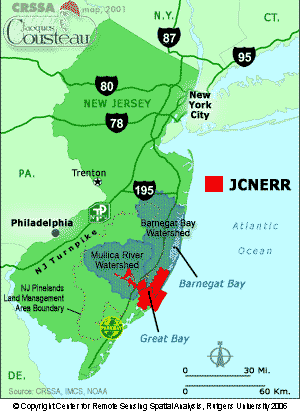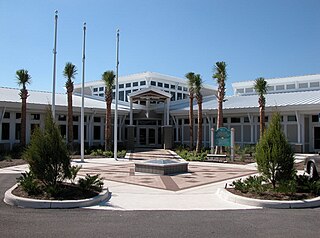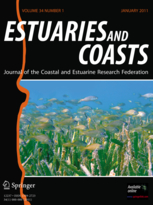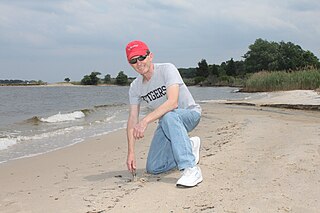
An estuary is a partially enclosed coastal body of brackish water with one or more rivers or streams flowing into it, and with a free connection to the open sea. Estuaries form a transition zone between river environments and maritime environments and are an example of an ecotone. Estuaries are subject both to marine influences such as tides, waves, and the influx of saline water, and to fluvial influences such as flows of freshwater and sediment. The mixing of seawater and freshwater provides high levels of nutrients both in the water column and in sediment, making estuaries among the most productive natural habitats in the world.

The National Estuarine Research Reserve System is a network of 29 protected areas established by partnerships between the National Oceanic and Atmospheric Administration (NOAA) and coastal states. The reserves represent different biogeographic regions of the United States. The National Estuarine Research Reserve System protects more than 1.3 million acres of coastal and estuarine habitats for long-term research, water-quality monitoring, education, and coastal stewardship.

The Severn Estuary is the estuary of the River Severn, flowing into the Bristol Channel between South West England and South Wales. Its high tidal range, approximately 50 feet (15 m), means that it has been at the centre of discussions in the UK regarding renewable energy.

The Smithsonian Environmental Research Center (SERC) is a United States 2,650-acre (10.7 km2) environmental research and educational facility operated by the Smithsonian Institution. It is located on the Rhode and West Rivers near Edgewater in Anne Arundel County, Maryland, near the western shore of Chesapeake Bay. The center's focus of study is the ecosystems of coastal zones, particularly in the Chesapeake Bay estuary and nearby wetlands.
The Earth Institute is a research institute at Columbia University that was established in 1995. Its stated mission is to address complex issues facing the planet and its inhabitants, with a focus on sustainable development. With an interdisciplinary approach, this includes research in climate change, geology, global health, economics, management, agriculture, ecosystems, urbanization, energy, hazards, and water. The Earth Institute's activities are guided by the idea that science and technological tools that already exist could be applied to greatly improve conditions for the world's poor, while preserving the natural systems that support life on Earth.

Bay mud consists of thick deposits of soft, unconsolidated silty clay, which is saturated with water; these soil layers are situated at the bottom of certain estuaries, which are normally in temperate regions that have experienced cyclical glacial cycles. Example locations are Cape Cod Bay, Chongming Dongtan Reserve in Shanghai, China, Banc d'Arguinpreserve in Mauritania, The Bristol Channel in the United Kingdom, Mandø Island in the Wadden Sea in Denmark, Florida Bay, San Francisco Bay, Bay of Fundy, Casco Bay, Penobscot Bay, and Morro Bay. Bay mud manifests low shear strength, high compressibility and low permeability, making it hazardous to build upon in seismically active regions like the San Francisco Bay Area.

The Jacques Cousteau National Estuarine Research Reserve, located in southeastern New Jersey, encompasses over 110,000 acres (450 km2) of terrestrial, wetland and aquatic habitats within the Mullica River-Great Bay Ecosystem.
Rookery Bay Reserve protects 110,000 acres of coastal lands and waters at the northern end of the Ten Thousand Islands on the gulf coast of Florida, Rookery Bay National Estuarine Research Reserve represents one of the few remaining undisturbed mangrove estuaries in North America.

In 1999, the Guana Tolomato Matanzas National Estuarine Research Reserve was designated in St. Johns and Flagler counties, Florida as a part of the National Oceanic and Atmospheric Administration (NOAA) National Estuarine Research Reserve (NERR) system. The GTM Research Reserve represents the east Florida sub-region of the Carolinian bioregion. It is one of 29 NERRs in 23 states and one territory. GTM is one of three NERRs in Florida, and is administered on behalf of the state by the Florida Department of Environmental Protection's Florida Coastal Office as part of a network that includes forty-one aquatic preserves, three NERRs, a National Marine Sanctuary, the Coral Reef Conservation Program and the Florida Oceans and Coastal Council. Additional interests are held in the research and management of the GTM and connected preserved or conserved lands including:

The Coastal and Estuarine Research Federation (CERF) is a private, nonprofit organization that was created in 1971. At that time, the members of two regionally based organizations, the Atlantic Estuarine Research Society (AERS) and the New England Estuarine Research Society (NEERS) recognized the need for a third estuarine organization that would address national estuarine and coastal issues. Today, CERF is a multidisciplinary federation of members and seven regionally based affiliate societies dedicated to the understanding and wise stewardship of estuaries and coasts worldwide.

Estuaries and Coasts is a peer-reviewed scientific journal published by Springer Science+Business Media and the official journal of the Coastal and Estuarine Research Federation. It was established in 1960 as Chesapeake Science by Romeo J. Mansueti, covering research results and management studies on natural resources of the Chesapeake Bay region. In 1977, the journal was acquired by the Coastal and Estuarine Research Federation and in 1978 it was renamed Estuaries. It obtained its current name in 2006. Chesapeake Science was published and partially subsidized by the Chesapeake Biological Laboratory during its 18-year history. The co-editors-in-chief are Linda Deegan and Paul Montagna.

The Ashepoo Combahee Edisto Basin National Estuarine Research Reserve is a 140,000-acre (570 km2) reserve area located in the ACE Basin, one of the largest undeveloped estuaries on the Atlantic coast of the United States. It is named for the Ashepoo, Combahee and Edisto Rivers, which flow past cypress swamps, historic plantation houses, old rice fields and tidal marshes to meet at South Carolina's biologically rich St. Helena Sound.
The Delaware National Estuarine Research Reserve consists of two unique components, one on Blackbird Creek and the other on the St. Jones River. Freshwater wetlands, ponds and forest lands dominate the Blackbird Creek component. The St. Jones component is dominated by salt marsh and open water habitats of the Delaware Bay.
Designated in 1991, the Chesapeake Bay National Estuarine Research Reserve - Virginia (CBNERR-VA) is one of 29 protected areas that make up the National Estuarine Research Reserve System (NERRS). Established to promote informed management of the nation's estuaries and coastal habitats, national estuarine research reserves inspire solutions for healthy coasts and maintain strong local economies, effectively functioning as America's bridge between freshwater and salt.
Restore America's Estuaries (RAE) is a national 501(c)(3) non-profit conservation organization dedicated to preserving the nation's network of estuaries through coastal protection and restoration projects which promote the richness and diversity of coastal life. Based in Arlington, VA with staff in Seattle, Colorado, and Florida, Restore America's Estuaries is an alliance of eleven community-based coastal conservation organizations that includes the American Littoral Society (ALS), Chesapeake Bay Foundation (CBF), Coalition to Restore Coastal Louisiana (CRCL), Conservation Law Foundation (CLF), Galveston Bay Foundation (GBF), North Carolina Coastal Federation (NCCF), Save The Bay – San Francisco (STB-SF), EarthCorps, Save The Bay – Narragansett Bay (STB-NB), Save the Sound (STS)-a program of Connecticut Fund for the Environment, and Tampa Bay Watch (TBW).
The Coastal and Marine Institute Laboratory (CMIL), formerly known as the Coastal Waters Laboratory, is an academic laboratory operated by the College of Sciences of San Diego State University (SDSU), in the Point Loma district of San Diego, California.
Florida Oceanographic Society is a non-profit organization founded in 1964 with the mission to inspire environmental stewardship of Florida's coastal ecosystems through education and research.

Michael J. Kennish is an American marine scientist and a research professor in the Institute of Marine and Coastal Sciences at Rutgers University in New Brunswick, New Jersey. He is best known for his work on the effects of human activities on estuarine and marine environments.
Herring River is a river in Wellfleet, Massachusetts that includes a tidal estuary. As of 2014, there are plans and funding in place to restore the river, after the construction of a dike across the river in 1909 as a mosquito control project severely hampered the health of the estuary.
Candace A. Oviatt is an ecologist at the University of Rhode Island known for research into coastal marine ecosystems with a particular focus on Narragansett Bay, Rhode Island.











